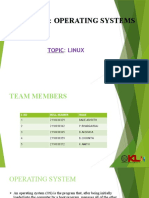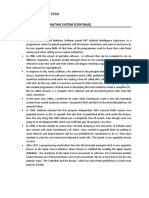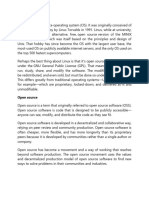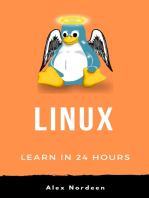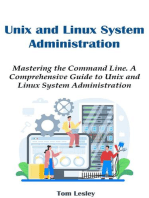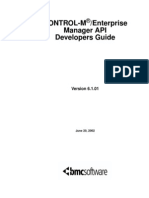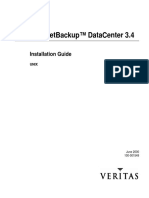Difference Between Linux and UNIX
Difference Between Linux and UNIX
Uploaded by
Sangana Koti ReddyCopyright:
Available Formats
Difference Between Linux and UNIX
Difference Between Linux and UNIX
Uploaded by
Sangana Koti ReddyOriginal Description:
Original Title
Copyright
Available Formats
Share this document
Did you find this document useful?
Is this content inappropriate?
Copyright:
Available Formats
Difference Between Linux and UNIX
Difference Between Linux and UNIX
Uploaded by
Sangana Koti ReddyCopyright:
Available Formats
Difference Between Linux and UNIX
by NI XCRAF T on FEBRUARY 23, 2006 251 COMM ENTS last updated at J ULY 9, 2010
hat is the difference between Linux and UNIX
operating systems? UNIX is copyrighted name only big companies are allowed to use the UNIX copyright and name, so IBM AIX and Sun Solaris and HP-UX all are UNIX operating systems. The Open Group holds the UNIX trademark in trust for the industry, and manages the UNIX trademark licensing program.
Most UNIX systems are commercial in nature.
Linux is a UNIX Clone
But if you consider Portable Operating System Interface (POSIX) standards then Linux can be considered as UNIX. To quote from Official Linux kernel README file: Linux is a Unix clone written from scratch by Linus Torvalds with assistance from a loosely-knit team of hackers across the Net. It aims towards POSIX compliance.
However, "Open Group" do not approve of the construction "Unix-like", and consider it misuse of their UNIX trademark.
Linux Is Just a Kernel
Linux is just a kernel. All Linux distributions includes GUI system + GNU utilities (such as cp, mv, ls,date, bash etc) + installation & management tools + GNU c/c++ Compilers + Editors (vi) + and various applications (such as OpenOffice, Firefox). However, most UNIX operating systems are considered as a complete operating system as everything come from a single source or vendor. As I said earlier Linux is just a kernel and Linux distribution makes it complete usable operating systems by adding various applications. Most UNIX operating systems comes with A-Z programs such as editor, compilers etc. For example HP-UX or Solaris comes with A-Z programs.
License and cost
Linux is Free (as in beer [freedom]). You can download it from the Internet or redistribute it under GNU licenses. You will see the best community support for Linux. Most UNIX like operating systems are not free (but this is changing fast, for example OpenSolaris UNIX). However, some Linux distributions such as Redhat / Novell provides additional Linux support, consultancy, bug fixing, and training for additional fees.
User-Friendly
Linux is considered as most user friendly UNIX like operating systems. It makes it easy to install sound card, flash players, and other desktop goodies. However, Apple OS X is most popular UNIX operating system for desktop usage.
Security Firewall Software
Linux comes with open source netfilter/iptables based firewall tool to protect your server and desktop from the crackers and hackers. UNIX operating systems comes with its own firewall product (for example Solaris UNIX comes with ipfilter based firewall) or you need to purchase a 3rd party software such as Checkpoint UNIX firewall.
Backup and Recovery Software
UNIX and Linux comes with different set of tools for backing up data to tape and other backup media. However, both of them share some common tools such as tar, dump/restore, and cpio etc.
File Systems
Linux by default supports and use ext3 or ext4 file systems. UNIX comes with various file systems such as jfs, gpfs (AIX), jfs, gpfs (HP-UX), jfs, gpfs (Solaris).
System Administration Tools
1. UNIX comes with its own tools such as SAM on HP-UX. 2. Suse Linux comes with Yast 3. Redhat Linux comes with its own gui tools called redhatconfig-*.
However, editing text config file and typing commands are most popular options for sys admin work under UNIX and Linux.
System Startup Scripts
Almost every version of UNIX and Linux comes with system initialization script but they are located in different directories: 1. HP-UX - /sbin/init.d 2. AIX - /etc/rc.d/init.d 3. Linux - /etc/init.d
End User Perspective
The differences are not that big for the average end user. They will use the same shell (e.g. bash or ksh) and other development tools such as Perl or Eclipse development tool.
System Administrator Perspective
Again, the differences are not that big for the system administrator. However, you may notice various differences while performing the following operations: 1. Software installation procedure 2. Hardware device names 3. Various admin commands or utilities 4. Software RAID devices and mirroring 5. Logical volume management 6. Package management 7. Patch management
UNIX Operating System Names
A few popular names: 1. HP-UX 2. IBM AIX 3. Sun Solairs 4. Mac OS X 5. IRIX
Linux Distribution (Operating System) Names
A few popular names: 1. Redhat Enterprise Linux 2. Fedora Linux 3. Debian Linux 4. Suse Enterprise Linux 5. Ubuntu Linux
Common Things Between Linux & UNIX
Both share many common applications such as: 1. GUI, file, and windows managers (KDE, Gnome) 2. Shells (ksh, csh, bash) 3. Various office applications such as OpenOffice.org 4. Development tools (perl, php, python, GNU c/c++ compilers) 5. Posix interface
A Sample UNIX Desktop Screenshot
Fig.01: UNIX Desktop - IRIX 6.5 Desktop
A Sample Linux Desktop Screenshot
Fig.02: Linux KDE desktop environment
UNIX and Linux Hardware
Commercial UNIX hardware has more advanced initial boot options such as: Decide how to boot Check system health Set hardware parameters etc The BIOS that is standard in PCs which is used by Linux has few, of these features. UNIX hardware or servers are pretty expensive as compare to Linux server systems.
Further readings: Following documents or URL should help anyone to get more idea:
UNIX System Management and Security: Differences between Linux, Solaris, AIX and HP-UX 40 years of Unix (Image credit IRIX and KDE wikipedia articles)
2 one
Linux vs Unix
Diffen Technology Computers Software Operating Systems Linux is an open source, free to use operating system widely used for computer hardware and software, game development, tablet PCS, mainframes etc. Unix is an operating system commonly used in internet servers, workstations and PCs by Solaris, Intel, HP etc.
nd
Comparison chart
Improve this chart
Linux Currently 3.96/5
Unix Currently 3.87/5
Rating: 4.0/5 (671 votes) What is it?: Linux is an example of Open Source software development andFree Operating System (OS). Linux can be freely distributed,
Rating: 3.9/5 (383 votes) Unix is an operating system that is very popular in universities, companies, big enterprises etc. Different flavors of Unix have
Cost:
Improve this chart
Linux Currently 3.96/5
Unix Currently 3.87/5
Rating: 4.0/5 (671 votes) downloaded freely, distributed through magazines, Books etc. There are priced versions for Linux also, but they are normally cheaper than Windows. Price: Free but support is available for a price.
Rating: 3.9/5 (383 votes) different cost structures
Some free for development use (Solaris) but support is available for a price. Unix operating systems were developed mainly for mainframes, servers and workstations. The Unix environment and the client-server program model were essential elements in the development of the Internet Three bigest distributions are Solaris (Oracle), AIX (IBM) & HP-UX Hewlett Packard. The UNIX operating system is used in internet servers, workstations & PCs. Backbone of the majority of finance infastructure and many 24x365 high availability solutions. x86/x64, Sparc, Power, Itanium, PA-
User:
Everyone. From home users to developers and computer enthusiasts alike.
Manufacturer:
Linux kernel is developed by the community. Linus Torvalds oversees things. Linux can be installed on a wide variety of computer hardware, ranging from mobile phones, tablet computers and video game consoles, to mainframes and supercomputers. Dozens of different kinds.
Usage:
Processors:
Improve this chart
Linux Currently 3.96/5
Unix Currently 3.87/5
Rating: 4.0/5 (671 votes)
Rating: 3.9/5 (383 votes) RISC and many others.
Architectures:
Originally developed for Intel's x86 hardware, ports available for over two dozen CPU types including ARM Ksplice - kernel update without reboot Linux typically provides two GUIs, KDE and Gnome. But Linux GUI is optional.
is available on PA-RISC and Itanium machines. Solaris also available for x86/x64 based systems. ZFS - Next generation filesystem Dtrace - dynamic kernel tracing Initially Unix was a command based OS, but later a GUI was created called Common Desktop Environment. Most distributions now ship with Gnome. jfs,gpfs,hfs,ufs,xfs,zfs format
Killer features:
GUI:
File system support: Text mode interface:
Ext2, Ext3, Ext4, Jfs, ReiserFS, Xfs, Btrfs, FAT, FAT32, NTFS BASH (Bourne Again SHell) is the Linux default shell. It can support multiple command interpreters. Linux has had about 60-100 viruses listed till date. None of them actively spreading nowadays. Linux is developed by Open Source development i.e. through sharing and collaboration of code and features
Originally the Bourne Shell. Now it's compatible with many others including BASH, Korn & C. A rough estimate of UNIX viruses is between 85 -120 viruses reported till date. Unix systems are divided into various other flavors, mostly developed by AT&T as well as various commercial
Security:
Development and Distribution:
Improve this chart
Linux Currently 3.96/5
Unix Currently 3.87/5
Rating: 4.0/5 (671 votes) through forums etc and it is distributed by various vendors such as Debian, Red Hat, SUSE, Ubuntu, GentuX etc. Threat detection and solution: In case of Linux, threat detection and solution is very fast, as Linux is mainly community driven and whenever any Linux user posts any kind of threat, several developers start working on it from different parts of the world Inspired by MINIX (a Unix-like system) and eventually after adding many features of GUI, Drivers etc, Linus Torvalds developed the framework of the OS that became LINUX in 1992. The LINUX kernel was released on 17th September, 1991
Rating: 3.9/5 (383 votes) vendors and non-profit organizations.
Because of the proprietary nature of the original Unix, users has to wait for a while, to get the proper bug fixing patch. But these are not as common.
Inception:
In 1969, it was developed by a group of AT&T employees at Bell Labs and Dennis Ritchie. It was written in C language and was designed to be a portable, multi-tasking and multiuser system in a time-sharing configuration.
3 one
1.5 What are the differences between Linux and UNIX?
rd
Command-line-wise, almost none, although this has been changing (for better or worse). Linux has a much larger market appeal and following than any commercial UNIX. GUI-wise there are also no major differences--Linux, as most other UNIXes, uses an X-Windowing system. The major differences:
Linux is free, while many UNICES (this is supposed to be the plural of UNIX), are very expensive. The same for applications--many good applications are available on Linux free. Even the same commercial application (if you wanted to buy one) typically costs much more for a commercial UNIX than for Linux. Linux runs on many hardware platforms, the commodity Intel-x86/IBM-spec personal computers being the most prominent. In contrast, a typical UNIX is proprietary-hardware-bonded (and this hardware tends to be much more expensive than a typical PC clone). With Linux, you are in charge of your computer, whereas on most UNICES you are typically confined to be an "l-user" (some administrators pronounce it "loser"). Linux feels very much like DOS/Win in the late 80s/90s, but is much sturdier and richer, while a typical UNIX account feels like a mainframe from the 60s/70s. Some UNICES may be more mature in certain areas (for example, security, some engineering applications, better support of cutting-edge hardware). Linux is more for the average Joe who wants to run his own server or engineering workstation.
4 one
Hello Friend, Unix and Linux are different operating systems. The main difference is between their interface type or method. Unix is a CUI operating system i.e. It is a character user interface operating system while Linux is a GUI operating system. GUI means graphical user interface. Character user interface is that system in which a human can interface with the system via characters only. You can use your keyboard to give inputs to your unix operating system while in Graphic user interface you can use both images and characters to give inputs to your system. Mouse can only be used in graphic user interface, while keyboard in both character user interface as well as in graphic user interface. If you are familiar with windows operating system then you can consider Unix as MS-Dos and Linux as MS - Windows. I think now the difference is clear to you. With best regards, Sunil Saharan Working for an ideal and peaceful society.
th
You might also like
- 100 PML's Tips and TricksDocument28 pages100 PML's Tips and TricksPrashant Prakash Uparkar100% (7)
- BASA 200 Brocade Associate SAN Administrator: Lab GuideDocument152 pagesBASA 200 Brocade Associate SAN Administrator: Lab Guidechandan_rhceNo ratings yet
- CMD CommandsDocument15 pagesCMD CommandsSapna PatelNo ratings yet
- Linux Is A UNIX Clone: Open Group HoldsDocument7 pagesLinux Is A UNIX Clone: Open Group HoldsShiva KumarNo ratings yet
- Difference Between Linux and UNIXDocument2 pagesDifference Between Linux and UNIXNeha KanojiaNo ratings yet
- Comparison Chart of Linux and UnixDocument3 pagesComparison Chart of Linux and UnixDayyan JDNo ratings yet
- OS UNIT IIDocument105 pagesOS UNIT IIyukthachowdarylavuNo ratings yet
- LP Lecture NotesDocument193 pagesLP Lecture Notesvahini SNo ratings yet
- Linux Project (Final)Document56 pagesLinux Project (Final)Rajat Goyal100% (2)
- Module 2Document23 pagesModule 2uswakhalid698No ratings yet
- Linux Programming Lecture NotesDocument190 pagesLinux Programming Lecture Notes7killers4u79% (19)
- Introduction To UNIXDocument67 pagesIntroduction To UNIXNeo DragonNo ratings yet
- Presentation 510 Content Document 20241110104928PMDocument48 pagesPresentation 510 Content Document 20241110104928PMrajusingh886617No ratings yet
- Linux NotesDocument347 pagesLinux Notesgundlapally_praveenkumar530No ratings yet
- LinusDocument15 pagesLinusAbel HaileNo ratings yet
- Linux Programming Lecture NotesDocument190 pagesLinux Programming Lecture Notesvivek1107khullarNo ratings yet
- LINUX MODULE-1 - NewDocument66 pagesLINUX MODULE-1 - NewFausiya SalimNo ratings yet
- Posted by Vivek Gite (Last Updated: January 12, 2007) : Difference Between Linux and UNIXDocument14 pagesPosted by Vivek Gite (Last Updated: January 12, 2007) : Difference Between Linux and UNIXSunilKumarANo ratings yet
- What Is An Operating SystemDocument5 pagesWhat Is An Operating Systemrashmi rashmiNo ratings yet
- Linux Simple NotesDocument24 pagesLinux Simple NotesSaiduluNo ratings yet
- Foss Practical 2 LinuxDocument6 pagesFoss Practical 2 LinuxPrachiti SalviNo ratings yet
- Linux Programming Lecture NotesDocument190 pagesLinux Programming Lecture NotesVishal SangishettyNo ratings yet
- Subject: Operating Systems: Topic: LinuxDocument26 pagesSubject: Operating Systems: Topic: LinuxB.C.H. ReddyNo ratings yet
- Linux BasicDocument37 pagesLinux BasicSejal PatilNo ratings yet
- Introducing and Installing Linux SystemDocument37 pagesIntroducing and Installing Linux SystemfdsaaNo ratings yet
- Individual Assignment 1: Course Title:Network and System AdministrationDocument18 pagesIndividual Assignment 1: Course Title:Network and System AdministrationFayera getachoNo ratings yet
- What Is UNIX ?: Redhat Enterprise LinuxDocument7 pagesWhat Is UNIX ?: Redhat Enterprise LinuxBijay KumarNo ratings yet
- HTTP Server by LinuxDocument15 pagesHTTP Server by LinuxAmitRajputNo ratings yet
- History of LinuxDocument7 pagesHistory of LinuxManoj Adhikari100% (1)
- Module 1 Linux History and Commands by Shakti SinghDocument6 pagesModule 1 Linux History and Commands by Shakti Singhsorout.sssNo ratings yet
- Linux Case StudyDocument3 pagesLinux Case StudyGuru PrasanthNo ratings yet
- Ulp FinalDocument269 pagesUlp Finalvivek kumarNo ratings yet
- What Is It?Document2 pagesWhat Is It?mohitohriNo ratings yet
- Unit-1 LinuxDocument18 pagesUnit-1 LinuxNikhil GharatNo ratings yet
- Chapter 5: Linux Operating System (Continue)Document11 pagesChapter 5: Linux Operating System (Continue)mohd firhan jasniNo ratings yet
- Case Study On LinuxDocument40 pagesCase Study On LinuxDivyanshuNo ratings yet
- Case Study On Linux Prof. Sujata RizalDocument40 pagesCase Study On Linux Prof. Sujata RizalRupesh SharmaNo ratings yet
- LINUXDocument6 pagesLINUXmishrashlok8No ratings yet
- Linux MOD 1Document55 pagesLinux MOD 1www.noelabraham60No ratings yet
- Linux AdmistrationDocument24 pagesLinux AdmistrationAli IzaldeenNo ratings yet
- Comparison of Operating SystemDocument26 pagesComparison of Operating SystemVivek Kumar GuptaNo ratings yet
- Introduction To UNIXDocument10 pagesIntroduction To UNIXmanishbhardwaj8131No ratings yet
- OS UNIT 6 NOTESDocument22 pagesOS UNIT 6 NOTESShlok GaikwadNo ratings yet
- Module IDocument14 pagesModule IAnandNo ratings yet
- Linux InglesDocument4 pagesLinux InglesThomas Abraham Jerez SanchezNo ratings yet
- FROM Http://markun - Cs.shinshu-U.ac - Jp/learn/linux/e - H - 01-01.htmlDocument3 pagesFROM Http://markun - Cs.shinshu-U.ac - Jp/learn/linux/e - H - 01-01.htmlMaree ThereseNo ratings yet
- Os FileDocument57 pagesOs Fileguptatulsi31No ratings yet
- Unit 2 History of LinuxDocument18 pagesUnit 2 History of Linuxtruptithakare27052004No ratings yet
- LINUX Programming: INSTRUCTOR: Ms. M. KeerthikaDocument4 pagesLINUX Programming: INSTRUCTOR: Ms. M. KeerthikaKeerthika MNo ratings yet
- RTOS UNIT-IV - ClassDocument64 pagesRTOS UNIT-IV - Classmanforlover7No ratings yet
- Shell ScriptingDocument177 pagesShell ScriptingFarhan Alam0% (1)
- UNIX-LINUX Training Material PDFDocument70 pagesUNIX-LINUX Training Material PDFraja75% (4)
- Linux Doc (1) (1) (1) (1) .Document52 pagesLinux Doc (1) (1) (1) (1) .Prithwish GhoshNo ratings yet
- Linux Basics (4th Year PUP)Document85 pagesLinux Basics (4th Year PUP)os29aNo ratings yet
- Unit 1Document6 pagesUnit 1laita nikamNo ratings yet
- UnixDocument4 pagesUnixPratikDagaNo ratings yet
- Intro To UnixDocument19 pagesIntro To Unixwoyevi6712No ratings yet
- 02 IntroLinuxDocument30 pages02 IntroLinuxHOÀNG NguyễnNo ratings yet
- Overview of LinuxDocument0 pagesOverview of LinuxAmit MishraNo ratings yet
- Linux: A Comprehensive Guide to Linux Operating System and Command LineFrom EverandLinux: A Comprehensive Guide to Linux Operating System and Command LineNo ratings yet
- Unix and Linux System Administration: Mastering the Command Line. A Comprehensive Guide to Unix and Linux System AdministrationFrom EverandUnix and Linux System Administration: Mastering the Command Line. A Comprehensive Guide to Unix and Linux System AdministrationNo ratings yet
- Linux for Beginners: Linux Command Line, Linux Programming and Linux Operating SystemFrom EverandLinux for Beginners: Linux Command Line, Linux Programming and Linux Operating SystemRating: 4.5 out of 5 stars4.5/5 (3)
- Ws - FTP Pro: User's GuideDocument172 pagesWs - FTP Pro: User's GuidesolmazbaharyNo ratings yet
- CM Enterprise Manager API Developers GuideDocument310 pagesCM Enterprise Manager API Developers GuideLuana DantasNo ratings yet
- Traffic RulesDocument14 pagesTraffic RulesSushrita MeshramNo ratings yet
- Quectel BG95BG77BG600L Series QCFG at Commands Manual V1.0Document42 pagesQuectel BG95BG77BG600L Series QCFG at Commands Manual V1.0LaloNo ratings yet
- Module3 - Quiz - UpdatedDocument29 pagesModule3 - Quiz - UpdatedRenato Gule GuljašNo ratings yet
- Oommf User's GuideDocument246 pagesOommf User's GuideJose ChristianNo ratings yet
- 2960CR PDFDocument788 pages2960CR PDFtc2020No ratings yet
- Microblaze Logicore IP Ds865 - Microblaze - McsDocument34 pagesMicroblaze Logicore IP Ds865 - Microblaze - McsAraceli Manzano ChicanoNo ratings yet
- M3 - T-TFGC-B - Writing Infrastructure Code For Google CloudDocument65 pagesM3 - T-TFGC-B - Writing Infrastructure Code For Google CloudMohan MuddaliarNo ratings yet
- RagePluginHook LogDocument55 pagesRagePluginHook Logremivincent270607No ratings yet
- Lab 1: Assembly Language Tools and Data RepresentationDocument9 pagesLab 1: Assembly Language Tools and Data Representationdarwinvargas2011No ratings yet
- Download, Install, and Set Up The Linux WorkloadDocument89 pagesDownload, Install, and Set Up The Linux WorkloadJedson AraujoNo ratings yet
- Lab 01 MATLABDocument7 pagesLab 01 MATLABUmer AshfaqNo ratings yet
- Start A Program As AdministratorDocument8 pagesStart A Program As AdministratormasoodkamaliNo ratings yet
- 875-1940-10 Veritas NetBackUp PDFDocument52 pages875-1940-10 Veritas NetBackUp PDFaksmsaidNo ratings yet
- Pluto 5 Enhanced Development Kit - Quick StartDocument35 pagesPluto 5 Enhanced Development Kit - Quick StartMitica ScurtuNo ratings yet
- RGFGRID User ManualDocument140 pagesRGFGRID User ManualcocoNo ratings yet
- KCT Administrator Guide PDFDocument370 pagesKCT Administrator Guide PDFРасул КичибековNo ratings yet
- Workato Connector SDK Cheat SheetDocument1 pageWorkato Connector SDK Cheat SheetsubraiNo ratings yet
- VPLEX - Replacement Procedures-VS6 Replace MMCS ReplacementDocument28 pagesVPLEX - Replacement Procedures-VS6 Replace MMCS Replacementbiml2002No ratings yet
- SoftX3000 Software Installation ManualDocument285 pagesSoftX3000 Software Installation ManualFelix_Andres_J_1121No ratings yet
- Sentinelsat Readthedocs Io en v0.12.2Document33 pagesSentinelsat Readthedocs Io en v0.12.2nanangjo212No ratings yet
- HP Linux Imaging and PrintingDocument7 pagesHP Linux Imaging and PrintingElio RivasNo ratings yet
- XXCOPY Command Parameters ReferenceDocument13 pagesXXCOPY Command Parameters ReferencedanessinNo ratings yet
- Vcs Db2 AgentDocument81 pagesVcs Db2 Agentsubhasghosal27No ratings yet
- AWS - Exercise 1 - Dev EnvironmentDocument5 pagesAWS - Exercise 1 - Dev EnvironmentRodrigo TeixeiraNo ratings yet
- 357090Document677 pages357090Nikunj MathurNo ratings yet






















